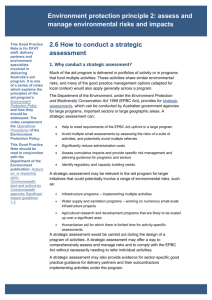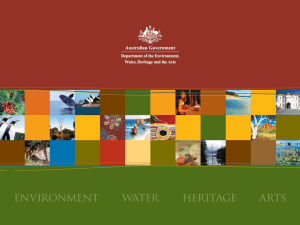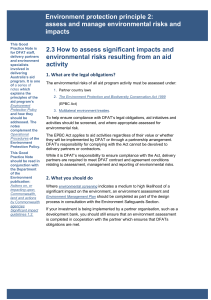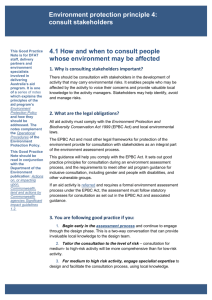Annual Compliance Report Guidelines
advertisement
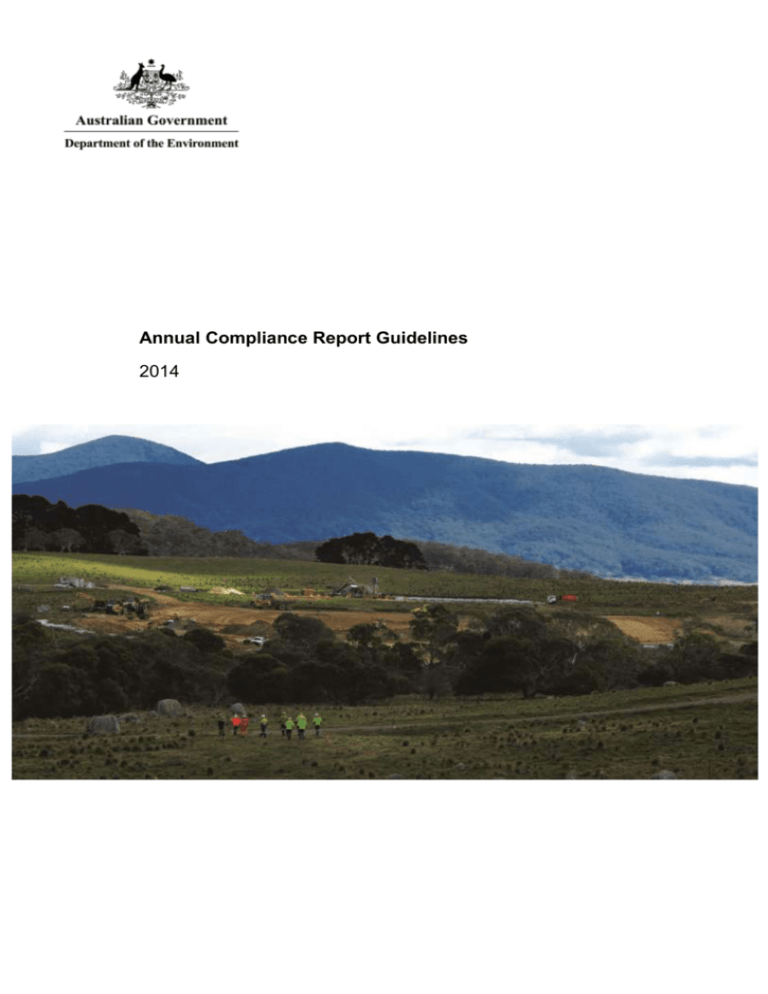
Annual Compliance Report Guidelines 2014 Annual Compliance Report Guidelines © Commonwealth of Australia 2014 Annual Compliance Report Guidelines are licensed by the Commonwealth of Australia for use under a Creative Commons By Attribution 3.0 Australia licence with the exception of the Coat of Arms of the Commonwealth of Australia, the logo of the agency responsible for publishing the report, content supplied by third parties, and any images depicting people. For licence conditions see: http://creativecommons.org/licenses/by/3.0/au/ This report should be attributed as ‘Annual Compliance Report Guidelines, Commonwealth of Australia 2014’. The Commonwealth of Australia has made all reasonable efforts to identify content supplied by third parties using the following format ‘© Copyright, [name of third party] ’. Requests and enquiries concerning reproduction and rights should be addressed to Department of the Environment, Public Affairs, GPO Box 787 Canberra ACT 2601 or email public.affairs@environment.gov.au Disclaimer The views and opinions expressed in this publication are those of the authors and do not necessarily reflect those of the Australian Government or the Minister for the Environment. This publication is not intended to constitute legal advice. While reasonable efforts have been made to ensure that the contents of this publication are factually correct, the Commonwealth does not accept responsibility for the accuracy or completeness of the contents, and shall not be liable for any loss or damage that may be occasioned directly or indirectly through the use of, or reliance on, the contents of this publication. Australian Government - Department of the Environment Environment Protection and Biodiversity Conservation Act 1999 - Guidelines Page 2 Annual Compliance Report Guidelines 1 Contents 1 2 3 INTRODUCTION ................................................................................................................................... 4 1.1 Compliance reports prepared to satisfy other regulations or regulatory bodies ............................... 4 1.2 Post-approval roles and responsibilities.......................................................................................... 4 1.3 Non-compliance ............................................................................................................................. 5 FORMAT ............................................................................................................................................... 6 2.1 General .......................................................................................................................................... 6 2.2 Digital requirements........................................................................................................................ 6 2.3 Revised compliance reports ........................................................................................................... 6 2.4 General requirements for maps, plans and sections ....................................................................... 6 2.5 Delivery address............................................................................................................................. 7 CONTENT OF THE COMPLIANCE REPORT ....................................................................................... 8 3.1 Declaration of accuracy .................................................................................................................. 8 3.2 Document version control ............................................................................................................... 9 3.3 Table of contents ............................................................................................................................ 9 3.4 Description of activities ................................................................................................................. 10 3.5 Addressing all approval conditions ............................................................................................... 10 3.6 EPBC approval conditions and the compliance table .................................................................... 10 3.7 Designations to record findings .................................................................................................... 11 3.8 Correcting non-compliances ......................................................................................................... 11 3.9 New environmental risks .............................................................................................................. 11 3.10 Other information.......................................................................................................................... 12 APPENDIX A: EXAMPLE OF COMPLIANCE TABLE ................................................................................. 13 Australian Government - Department of the Environment Environment Protection and Biodiversity Conservation Act 1999 - Guidelines Page 3 Annual Compliance Report Guidelines 1 INTRODUCTION The purpose of this document is to provide guidance to approval holders preparing annual compliance reports where required under a condition of their Environment Protection and Biodiversity Conservation Act 1999 (the EPBC Act) approval. Information about the EPBC Act assessment and approval process is available on the Department of the Environment’s (Department) website at http://www.environment.gov.au/topics/about-us/legislation/environment-protection-and-biodiversityconservation-act-1999. These guidelines firstly provide an overview of the responsibilities of both the approval holder and the role of the Department in the post-approval process. They also provide guidance on the required content and formatting of the compliance report. They contain a sample compliance table which the Department recommends be included in every annual compliance report. 1.1 Compliance reports prepared to satisfy other regulations or regulatory bodies These guidelines highlight the information that must be included, and clearly identified, in an annual compliance report under the EPBC Act. However, the Department understands that in addition to meeting EPBC Act obligations, approval holders may need to prepare a compliance report to satisfy the requirements of other regulations or regulatory bodies. Accordingly, the Department recognises that the format of compliance reports may need to vary. The Department will accept reports prepared for other regulators providing they include the information specified in these guidelines and the conditions compliance table described in Section 3.6 and Appendix A of these guidelines. The reports should clearly articulate the different requirements included for each regulator. 1.2 Post-approval roles and responsibilities The Department recognises that most members of the regulated community will voluntarily comply with legislation if they are provided with guidance, and assistance is readily available. Approval holders are encouraged to undertake responsible self regulation and to implement systems and practices to ensure actions are undertaken in compliance with the EPBC Act. Department’s Compliance and Enforcement Branch The Department’s Compliance and Enforcement Branch deliver an effective compliance monitoring and audit regime for approvals under the EPBC Act – thus ensuring compliance with conditions of approval. Compliance and Enforcement Branch is responsible for providing assistance to EPBC approval holders so that they can meet the obligations set out in the approval. Requests for assistance or clarification are encouraged and should be sent in writing to post.approvals@environment.gov.au or: Audit and Assurance Section Compliance and Enforcement Branch Environment Assessment and Compliance Division Department of the Environment GPO Box 787 CANBERRA ACT 2601 Australian Government - Department of the Environment Environment Protection and Biodiversity Conservation Act 1999 - Guidelines Page 4 Annual Compliance Report Guidelines Service Charter The Departmental service charter sets out the standards of service clients can expect from us, their rights and responsibilities and how to find out more about the Department. 1.3 Non-compliance The Department undertakes a range of compliance activities to ensure the regulated community is aware of their possible obligations under the EPBC Act. When contraventions occur, the EPBC Act provides enforcement options that include a range of criminal and civil penalties, and civil and administrative remedies. The Department undertakes monitoring inspections, desk top document reviews and compliance audits as part of its Annual Compliance Plan. Annual and intermittent desktop document reviews are undertaken to determine the status of projects and ascertain compliance against conditions. Approval holders are expected to assist the Department with these reviews. Projects that are subject to a full compliance audit are chosen either via a random selection process or through a risk-focussed strategic selection process as part of an annual strategic compliance audit program. This document is not intended to provide guidance to approval holders directed to undertake full compliance audit. Compliance Reports Compliance reports help to ensure projects with the potential to impact on matters protected under the EPBC Act are implemented as approved. The compliance reports also help the Australian Government to understand how well approval conditions are being understood and applied, and contribute to improving the effectiveness of the Department's operations. Further information can be found on the Department’s website at http://www.environment.gov.au/epbc/compliance/auditing.html. Approval holders are encouraged to maintain accurate records of all activities associated with or relevant to the conditions of approval, so that they can be made available to the Department on request. Such documents may be subject to audit and used to verify compliance. This may also be a condition that is attached to an approval. Compliance and Enforcement Policy The Department’s approach to compliance and enforcement is set out in its Compliance and Enforcement Policy, which is available on its website at: http://www.environment.gov.au/epbc/publications/epbccompliance-enforcement-policy.html. Approval holders are expected to self-report potential non compliances upon becoming aware of them. Self-reporting enables the Department to address instances of non compliances as early as possible and may help to prevent the issue from escalating or becoming more severe. Australian Government - Department of the Environment Environment Protection and Biodiversity Conservation Act 1999 - Guidelines Page 5 Annual Compliance Report Guidelines 2 2.1 FORMAT General Each page of the compliance report should include the EPBC approval number, the name of the project, the date of the report and sequential page numbering. A compliance report can be submitted via standard post or electronically. Submissions should be titled ‘Compliance Report’ with the project name and EPBC approval number. The time period the report relates to should be clearly stated (e.g. 10 October 2013 to 10 October 2014). 2.2 Digital requirements The Department uses an electronic document management system. The complete report (text, figures and appendixes) is to be supplied as an Adobe Acrobat PDF file. At a minimum, the PDF document is to be bookmarked to the major components (e.g. contents, main report and appendices). However, where this is not possible, the Department will accept individual components in any available format. Where individual digital components are supplied, please provide a file list and the corresponding report reference. Electronic data will be accepted via email or on CD, DVD or USB memory stick. 2.3 Revised compliance reports The Department may request that a compliance report be revised and resubmitted. A resubmitted report should be accompanied by an electronic copy of the document showing tracked changes from the previous report. 2.4 General requirements for maps, plans and sections All maps and sections should conform to the following standards. Scale – An appropriate standard metric scale should be chosen to best represent the information required (e.g. 1:25 000, 1:10 000 and 1:5000). Datum – Plans and cross sections should refer to Australian Height Datum. Title Block – Plans should have a title block in the lower right hand corner of the sheet with the following information: o o o o o EPBC number and project name title and number of the plan author scale date. Legend – Plans should have a clear and comprehensive legend to identify the symbols and colours used. Maps, plans, figures, images and sections should also: o use metric measurements throughout Australian Government - Department of the Environment Environment Protection and Biodiversity Conservation Act 1999 - Guidelines Page 6 Annual Compliance Report Guidelines o o o o 2.5 show a graphic bar scale show any local grid lines and standards have a north point or orientation of sections include a key. Delivery address Compliance reports should be titled ‘Compliance Report’ with the project name and EPBC approval number, clearly labelled beneath the title. Compliance reports should be forwarded to: Post Audit and Assurance Section Compliance and Enforcement Branch Environment Assessment and Compliance Division Department of the Environment GPO Box 787, Canberra ACT 2601 Email post.approvals@environment.gov.au The above contact details can also be used if you are seeking further advice on preparing a compliance report. Australian Government - Department of the Environment Environment Protection and Biodiversity Conservation Act 1999 - Guidelines Page 7 Annual Compliance Report Guidelines 3 CONTENT OF THE COMPLIANCE REPORT 3.1 Declaration of accuracy A person must not knowingly provide information to the Department that is false or misleading (see sections 490 and 491 of the EPBC Act). The extract below from the EPBC Act should be considered in the context of the Act as whole, including any related sections and any relevant definitions. You should seek your own legal advice regarding interpretation of the sections. 490 Providing false or misleading information in response to a condition on an approval or permit (1) A person is guilty of an offence if: (a) the person is the holder of an environmental authority; and (b) a condition attached to the environmental authority requires the person to provide information; and (c) the person provides information in response (or purportedly in response) to the requirement; and (d) the person is reckless as to whether the information is false or misleading in a material particular. Note: The fault element in paragraph (1)(d) can be demonstrated by proof of knowledge. See subsection 5.4(4) of the Criminal Code. (2) The offence is punishable on conviction by: (a) imprisonment for a term not more than 2 years, a fine not more than 120 penalty units, or both, if it is proved the person knew the information was false or misleading; or (b) imprisonment for a term not more than 1 year, a fine not more than 60 penalty units, or both, if it is proved the person was reckless as to whether the information was false or misleading. Note: Subsection 4B(3) of the Crimes Act 1914 lets a court fine a body corporate up to 5 times the maximum amount the court could fine a person under this subsection. 491 Providing false or misleading information to authorised officer etc. (1) A person is guilty of an offence if the person: (a) provides information or a document to another person (the recipient); and (b) knows the recipient is: (i) an authorised officer; or (ii) the Minister; or (iii) an employee or officer in the Department; or (iv) a commissioner; performing a duty or carrying out a function under this Act or the regulations; and (c) knows the information or document is false or misleading in a material particular. (2) The offence is punishable on conviction by imprisonment for a term not more than 1 year, a fine not more than 60 penalty units, or both. Note: Subsection 4B(3) of the Crimes Act 1914 lets a court fine a body corporate up to 5 times the maximum amount the court could fine a person under this subsection. Australian Government - Department of the Environment Environment Protection and Biodiversity Conservation Act 1999 - Guidelines Page 8 Annual Compliance Report Guidelines The declaration below should be attached to the compliance report and signed by the approval holder. If the approval holder has sub-contracted the project (or part thereof), or the preparation of the compliance report, the responsibility for accuracy still lies with the approval holder: Declaration of accuracy In making this declaration, I am aware that sections 490 and 491 of the Environment Protection and Biodiversity Conservation Act 1999 (Cth) (EPBC Act) make it an offence in certain circumstances to knowingly provide false or misleading information or documents. The offence is punishable on conviction by imprisonment or a fine, or both. I declare that all the information and documentation supporting this compliance report is true and correct in every particular. I am authorised to bind the approval holder to this declaration and that I have no knowledge of that authorisation being revoked at the time of making this declaration. Signed _____________________________________________ Full name (please print) _____________________________________________ Position (please print) _____________________________________________ Organisation (please print including ABN/ACN if applicable) Date 3.2 ___________________ ______/______/______ Document version control The document version control system should be a simple system for ensuring version control and documenting details of key changes to the document over time. It should identify changes and include details of timing, people responsible and reasons for those changes. 3.3 Table of contents The table of contents should contain: all section headings and page numbers all figures, tables, plans and maps (should be numbered) all appendices (with meaningful titles, including sub-appendices if any); if appendices contains a collation of data, include summary of the contents Australian Government - Department of the Environment Environment Protection and Biodiversity Conservation Act 1999 - Guidelines Page 9 Annual Compliance Report Guidelines 3.4 Description of activities The description of activities section should contain a description of the approved action and details of the current activities undertaken during the period covered by the report. The compliance report should clearly identify: 3.5 EPBC number project name approval holder and ACN or ABN the approved action location of the project person accepting responsibility for the report – signed declaration (see Section 3.1) dates for the reporting period of the report date of preparation of the report. Addressing all approval conditions The compliance report should: demonstrate that all conditions of the EPBC approval have been considered and addressed list the conditions of the EPBC approval, including any variations to those conditions, noting if compliance or non compliance with each condition has been achieved. If a management plan is required under an approval condition: 3.6 the specifics in a management plan that support an approval condition should be detailed in the compliance report material should be provided demonstrating that the requirements of that plan have been implemented. EPBC approval conditions and the compliance table As part of every compliance report the Department requests that a conditions compliance table in a similar format to that in Appendix A be included. The table should include: the full wording of all conditions under the EPBC approval the condition reference number a designation regarding compliance or non-compliance a summary of evidence and comments to support the compliance designation references to any other parts of the compliance report which relate to that approval condition. The hypothetical approval conditions compliance table at Appendix A includes an example of a condition requiring the implementation of a management plan and how that could be addressed. The compliance report needs to make a clear statement that operations were, or were not, compliant with the EPBC conditions of approval. The statement should be supported by a summary of evidence clearly demonstrating the conclusion that compliance with the condition was (or was not) fully met. Supporting data Australian Government - Department of the Environment Environment Protection and Biodiversity Conservation Act 1999 - Guidelines Page 10 Annual Compliance Report Guidelines such as flora and fauna surveys, photograph monitoring and groundwater monitoring data should be provided as appendices. 3.7 Designations to record findings The following designations should be used to record findings in compliance reports: Compliant ‘Compliance’ is achieved when all the requirements of a condition have been met, including the implementation of management plans or other measures required by those conditions. Non-compliant A designation of ‘non-compliance’ should be given where the requirements of a condition or elements of a condition, including the implementation of management plans and other measures, have not been met. Not applicable A designation of ‘not applicable ‘ should be given where the requirements of a condition or elements of a condition fall outside of the scope of the current reporting period. For example a condition which applies to an activity that has not yet commenced. 3.8 Correcting non-compliances Findings of non-compliance should be accompanied by a summary detailing any corrective measures taken and include: o o o o o o o o the relevant EPBC approval condition number who detected the non-compliance date the non-compliance was detected was the Department notified of the non-compliance and if so, when and how how the non-compliance was/will be corrected who (the actual person completing the correction) was/is responsible for correcting the noncompliance date correction measures were/will be commenced and/or completed or the time frame for correction what measures have been/ will be taken to avoid recurrence. Instances of non-compliance included in previous compliance reports which were not fully corrected at the end of the reporting period, should have a progress update in the subsequent report and an assessment of the effectiveness of the measures taken. 3.9 New environmental risks The compliance report should discuss any new environmental risks that have become apparent during the reporting period. New environmental risks may include new pest or diseases, new information on groundwater levels, unexpected erosion etc. If new risks are identified, there should be risk analysis and Australian Government - Department of the Environment Environment Protection and Biodiversity Conservation Act 1999 - Guidelines Page 11 Annual Compliance Report Guidelines reporting. A commitment to review the appropriate management plan (if required) should be included in the compliance report. 3.10 Other information Any additional monitoring or environmental research information relevant to the EPBC approval and approval conditions can be included in the relevant section or appended to the compliance report. Appendices can be attached to support reporting against the EPBC approval conditions. Colour photographs and/or aerial photography can provide an excellent time record of the operation and may be included. Any additional information such as supporting documentation, consultant studies and reports should be appended. Australian Government - Department of the Environment Environment Protection and Biodiversity Conservation Act 1999 - Guidelines Page 12 Annual Compliance Report Guidelines APPENDIX A Example of EPBC approval conditions compliance table Condition Condition Number/ reference Include the complete wording of the condition, or sub-condition that is E.g. ‘3(c)’ being addressed. Is the project compliant with this condition? Evidence/Comments 1 Within 10 business days of the date of commencement of the action, the person taking the action must advise the Department in writing of the actual date of commencement. Compliant Commencement of the action occurred on 15 June 2010 (see appendix 1 – attached copy of the sent notification) – Compliant 2 To mitigate impacts on listed migratory bird species the person taking the action must provide a 200 metre vegetation setback and boundary fencing between the golf course boundary on Lot 1 and the estuary. The setback must be in place prior to commencement of the action. Non-compliant The 200 metre vegetation setback and boundary fencing between the golf course boundary on Lot 1 and the estuary was not in place until after commencement of the action – Non compliant Evidence to support claims regarding compliance or non-compliance. Compliant/ Non-Compliant/ Not applicable Australian Government - Department of the Environment Environment Protection and Biodiversity Conservation Act 1999 - Guidelines Page 13 Annual Compliance Report Guidelines 3 Prior to commencement of the action, the person taking the action must prepare and submit for the Minister’s approval, a Fern Environmental Management Plan for the Hypothetical Fern Species within the 200 metre vegetation setback required under condition 2 of this approval. The approved plan must be implemented. Compliant The plan must include: A 10 year monitoring program of Fern numbers and distribution within the 200 metre vegetation setback. A seven year program of weed control for the set back area. Procedures for managing impacts on ferns in the set back area if the monitoring program finds that the fern population numbers drop below 50. This includes notifying the Department of this drop in population and the management actions undertaken. The action commenced on 15 June 2010. Yes, the Fauna Management Plan was submitted prior to commencement of the action and approved on 30 March 2010. The approved monitoring program requires surveys to be undertaken once every two years. Three surveys have been undertaken so far and the population continues to be stable at 73 specimens. Weed control activities were last undertaken in spring 2014. Appendix 2 lists all the requirements of the Fern Environmental Management Plan and states how the requirements have been met. It includes a summary of the survey results and weed control records. Australian Government - Department of the Environment Environment Protection and Biodiversity Conservation Act 1999 - Guidelines Page 14 Annual Compliance Report Guidelines 4 Prior to commencement of the action, the person taking the action must prepare and submit for the Minister’s approval, a Fauna Management Plan to minimise impacts on the Hypothetical Potoroo Species. The approved plan must be implemented. Non-compliant The action commenced on 15 June 2010. No, the Fauna Management Plan was not submitted prior to commencement of the action. No, the Fauna Management Plan was not approved by the Minister However, the Fauna Management Plan was prepared and has been implemented. (see appendix 2) (appendix 3 lists all the requirements of the management plan and state how the requirements have been met) 5 (a) Within 10 business days of the date of completion of construction of the clubhouse car park extension, highlighted as Car park 4 in the map at Attachment A, the approval holder must advise the Department in writing that construction of the car park is complete. Not applicable Construction of the clubhouse car park extension has not yet commenced. We expect to commence work on it in August 2014 and complete it by March 2015. Australian Government - Department of the Environment Environment Protection and Biodiversity Conservation Act 1999 - Guidelines Page 15
